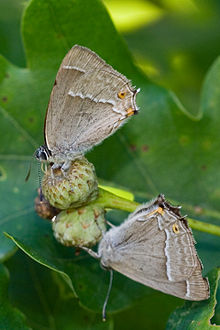- Purple Hairstreak
-
Purple Hairstreak 

Scientific classification Kingdom: Animalia Phylum: Arthropoda Class: Insecta Order: Lepidoptera Family: Lycaenidae Genus: Neozephyrus Species: N. quercus Binomial name Neozephyrus quercus
(Linnaeus, 1758)The Purple Hairstreak Neozephyrus quercus is a butterfly in the family Lycaenidae distributed throughout much of Europe.[1] North Africa, Asia Minor, Caucasus and Transcaucasia. The larva feeds on Quercus robur, Quercus petraea, Quercus cerris and Quercus ilex.
Contents
Subspecies
- N. quercus interjectus (Verity , 1919) Italy
- N. quercus longicaudatus (Riley , 1921) West Iran, Azerbaijan, Turkey
- N. quercus iberica (Staudinger , 1901) Morocco, Algeria, Iberia
United Kingdom and Ireland
Appearance, behaviour and distribution
This active little butterfly is most often seen fluttering around high up in oak trees on warm sunny July and early August days. Males have a glossy purple sheen on the upperside, females have two patches on the forewing only. The underside is light grey with a white streak, edged in black, running down the middle of both wings. The hindwings have a short tail with two orange spots at the base on the underside. It is common and widespread across southern and central England and Wales, becoming rarer and more isolated in the north as far as central Scotland. In Ireland it occurs in a few isolated colonies scattered across the country but is probably still under recorded due to its reclusive habits. Males tend to stay high up in trees, females come down to lower levels to lay eggs. Both sexes feed mainly on honeydew although females are occasionally attracted to flowers whilst taking a break from egg laying.
Life cycle and foodplants
Eggs are laid singly at the base of oak buds in late summer ready to hatch the following spring as the buds break. Both Sessile Oak Quercus petraea and Pendunculate Oak Quercus robur, Britain's two native oaks are used and also some introduced species such as Turkey Oak Quercus cerris and Evergreen oak Quercus ilex. In winter the eggs are easily found on close examination of bare branches. The caterpillar is fully developed inside the egg after two or three weeks but doesn't hatch until the spring whereupon it burrows into the flower buds to feed safely concealed. As it gets larger and the buds open it spins a silken retreat and feeds only at night. Pupation usually takes place in the leaf litter where it is tended by ants who bury them, but also sometimes in a crevice in the bark of the foodplant. There is one brood a year with adults on the wing in July and August.
References
See also

This Theclinae-related article is a stub. You can help Wikipedia by expanding it.




